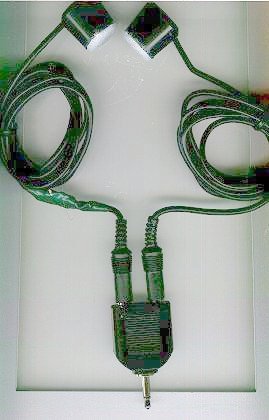1) The long cord is plugged into the "speaker out" jack on your sound
card.
2) The signals are applied using the coils. Listening to them won't have any effect.
3) Test sessions are not nessessary for sessions done using the same signal over
both sides of your head.
BASIC SAFETY POINTS
4) If you choose session designs that apply a signal to one side only, you will
need to apply that signal to each side of your head, to feel the effects briefly before you begin with longer sessions.
10 minutes should be sufficient. If you don't feel anything, then you probably don't have a reversed structure.
5) Do not do more than one session every 72 hours. Testing one signal over each
side counts as one session. Doing the test sessions all at once can lead to unpleasant effects, and can confuse
the results. Test one signal at a time. Do not do more than one test every 72 hours.
6) If a session is a 'dud', try another design for the next session. Wait the
full 72 hours before doing your next one. Note that shorter sessions (30 minutes or less) are not designed to elicit
effects during sessions, but rather are intended to create after effects.
7) Make sure your coils are completely plugged in.
8) Do not move the coils during a session, except as directed for an advanced
session design.
9) Do not change signals during a session.
10) For tech support (unwanted effects or hardware issues), visit www.spiritualbrain.com,
and use any e-mail link.
|

|
NOTE:
There are four types of Coils. With tape in the cord, and without tape
on the cord. Left and right. One pair of coils has one with tape and one without (one is 'north' and the other
is 'south'.) Each side of the head gets two pairs (for the 8-Coil Shakti). One pair is from the left stereo channel,
and the other pair is from the right stereo channel
<< This is one pair
of coils. All configurations (2, 4, or 8 coils) use pairs of coils like this. One with tape, and one without.
For the eight coil unit, each side of your head gets one left without tape,
one left with tape, one right without tape, and one right with tape (as shown below).
L TAPED CORD
No tape R ................. R Taped cord
L No
tape on cord
|
NOTE: Left and right coils are from the left and right stereo channels, NOT for
the left and right side of your head.
Which signals do you use?
To decide this, you need to read about the various signals, and then decide. You might like to know that
the most commonly used signal in lab studies is the amygdaloid signal, and that the most successful place to use
it is either over the temporal lobes, either over both sides of your head, or on the left only. In contrast, the
most successful Shakti session for most people appears to be the FeelGood session, which is designed to produce positive
after-effects, not effect during sessions. The Altered
States Session is a good choice for effects during sessions.
You need a quick way to set your volume?
You can use the Shakti Level Meter (under TOOLS in the menu) to set your volume to 75% - this will work for most (not all) sound cards. There
are other methods,
and some of them are more accurate.
Which session design is most likely to produce effects like I saw on TV?
Those are two-phase sessions, and the TV segments were usually filmed in the second phase. The sessions designs in Shakti
do not duplicate the ones that appeared on documentaries exactly, but these come close.
Is my sound card good enough?
Most sound cards are good enough for use with Shakti, and you can test yours to see if it gets low enough tones.
If you do, you should be sure to follow the instructions carefully. It's not enough to play the low tones, you
also have to have your volume raised to the maximum, and that takes two controls. Use the Shakti Level Meter to be sure your volume is
at 100% when doing this test. Most laptop sound cards are good enough, but if you have trouble with yours, you
can get an external USB
sound device, and most of these have all the output you need, and
a little bit more.
How do I arrange the coils?
No matter which location you choose, the basic arrangement is the same. Two left-channel
coils (one with tape and one without), and two right-channel coils (also one with tape and one without) set perpendicular
to one another, as shown below: